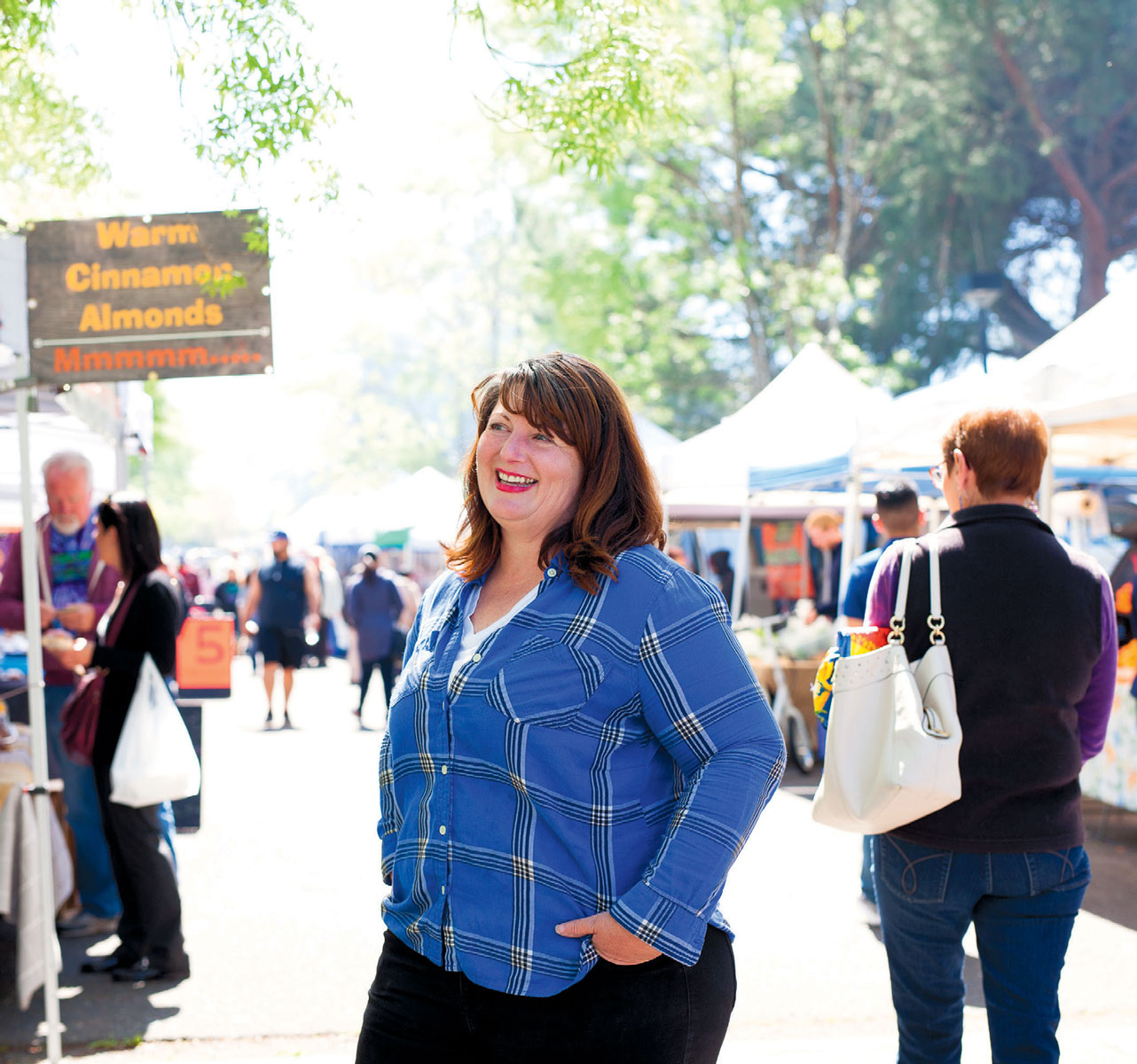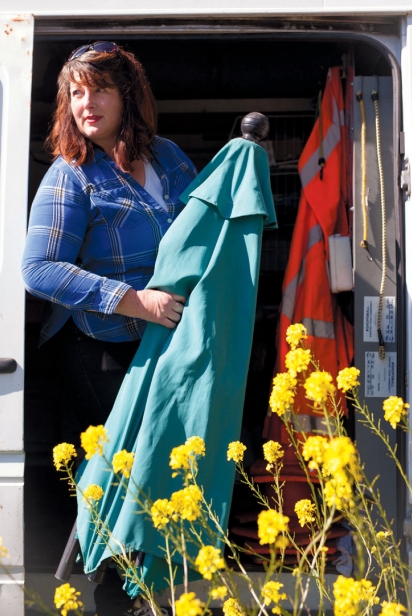Not Just Anybody's Tuesday
A DAY IN THE LIFE OF A MULTIPLE FARMERS’ MARKET OPERATOR
Kelly Smith, executive director of the nonprofit Agricultural Community Events Farmers’ Markets (ACEFM) organization, keeps farmer’s hours. Though she does not have cows that need milking, Smith is up before dawn every day, juggling the needs of the 11 markets in Marin and Sonoma counties that are operated under the ACEFM umbrella.
The first order of the day is social media marketing on behalf of whichever markets are operating that day, confirming which farmers and other vendors will be at the market and posting the news to the market’s Facebook community. If there is enough time (if it is rainy, those confirming calls might be all that Smith has time for), she squeezes in some of the ceaseless accounting that makes farmers’ market shopping accessible to a significant number of her customers. From charging the Electronic Benefit Transaction reader (a de facto ATM that enables the markets to accept payments from SNAP, the federal Supplemental Nutrition Assistance Program), to precisely recording transactions for California’s state-run Market Match program (another healthy food incentive program, which matches customers’ federal nutrition assistance benefits from SNAP; WIC, the Special Supplemental Nutrition Program for Women, Infants and Children; and other programs) into a Google document, Smith pushes a lot of cloud-based paper when she is not wrangling market vendors.
“Very few days run smoothly,” says Smith, who founded ACEFM in 2010 after she had unsuccessfully sought booth space at a local farmers’ market to showcase her line of handcrafted soaps. There was clearly the need for another market (or several) to accommodate the large number of worthy local farmers and producers wanting to showcase their products to local consumers.
Smith’s entrepreneurial background seemed perfect for the role, and she saw it as a way to support not only her own soap enterprise, but other small local businesses. She accepted the challenge, launching the first ACEFM market at Marinwood with her fiancé, Jim Fenton. “And then it snowballed,” she says.
Smith recognized early on that she could not be in two places at the same time, a problem that grew exponentially as the number of markets she administers grew to the current 11. Her small staff, including Fenton, is augmented with seasonal employees when the summer market season is in full swing, and dedicated volunteers.
More than ever before, Smith says she is excited for this season’s markets. Winter rains came early and often, meaning markets are expected to overflow with produce long before July. And, after last autumn’s devastating fires, shopping at local farmers’ markets is a great opportunity for community members to reconnect with each other and to support the people who grow and produce food within our foodshed.
“People are hungry for farmers to come back,” Smith says. With markets operating throughout Marin, Napa and Sonoma counties through late autumn, and many year-round, shopping at local farmers’ markets is a meaningful way to help support recovery efforts in our area. No farmer’s hours required.
For a list of markets operated by Agricultural Community Events Farmers’ Markets, visit CommunityFarmersMarkets.com. For a complete list of farmers’ markets in our area, visit EdibleMarinAndWineCountry.com/EdibleCommunities.com/Shop/Farmers-Marketsand-CSAs-Marin-Napa-and-Sonoma-Counties.
ANY GIVEN TUESDAY IN THE LIFE OF KELLY SMITH
• Wake up between 5:30 and 6am.
• Answer calls from vendors who cannot attend that day and queries from vendors who want to fill in.
• Create a Facebook post for Petaluma East Side and Novato markets, both of which operate on Tuesdays, listing and tagging vendors who are attending that day.
• Help Fenton pack ACEFM’s Sprinter van with “the market,” aka everything he needs to run the Petaluma East Side market, including:
1. Receipts for all the vendors (for booth payments)
2. Fully charged EBT for SNAP transactions
3. Market Match sheet
4. Square device to process Market Match transactions
4. Charged iPad and Square reader
5. Market Money, WIC and Senior WIC tokens.
• Pack up anything she needs to run the Novato market later that day— if it’s not already loaded. This includes tables and chairs, the musicians’ booth (includes a generator, chair and canopy), and the information booth, plus all the paperwork and currencies required for vendors and customer transactions, same as required for the Petaluma East Side market.
• Answer emails.
• Drive to the Petaluma East Side market to help Jim shut down that market at 1:30pm, swapping her car for the loaded Sprinter van and relieving Jim if his son, a 15-year-old with special needs, needs to be picked up after school that day.
• Pack up “the market” from the Petaluma East Side market and drive to the Novato market site.
• Set up the Novato market in time for its 4pm opening.
• Answer last-minute texts, phone calls and emails from vendors who are either coming or not coming.
• Remain onsite during the market to collect vendor booth payments, convert WIC and Market Match payments to cash for vendors and respond to vendor and customer needs.
• Purchase and eat dinner (if possible).
• Close down the market at 8pm.
• Repack “the market” into the Sprinter van.
• Hand off “the market” to Karen Marks, market manager for ACEFM’s Cotati and Fairfax markets, for the seasonal Wednesday market in Fairfax.
• Ensure the market site is clear by 9pm.
• Drive home to Kenwood, hopefully by 10pm, so she can wind down a bit before doing it all over again starting at 5:30 the next morning.










